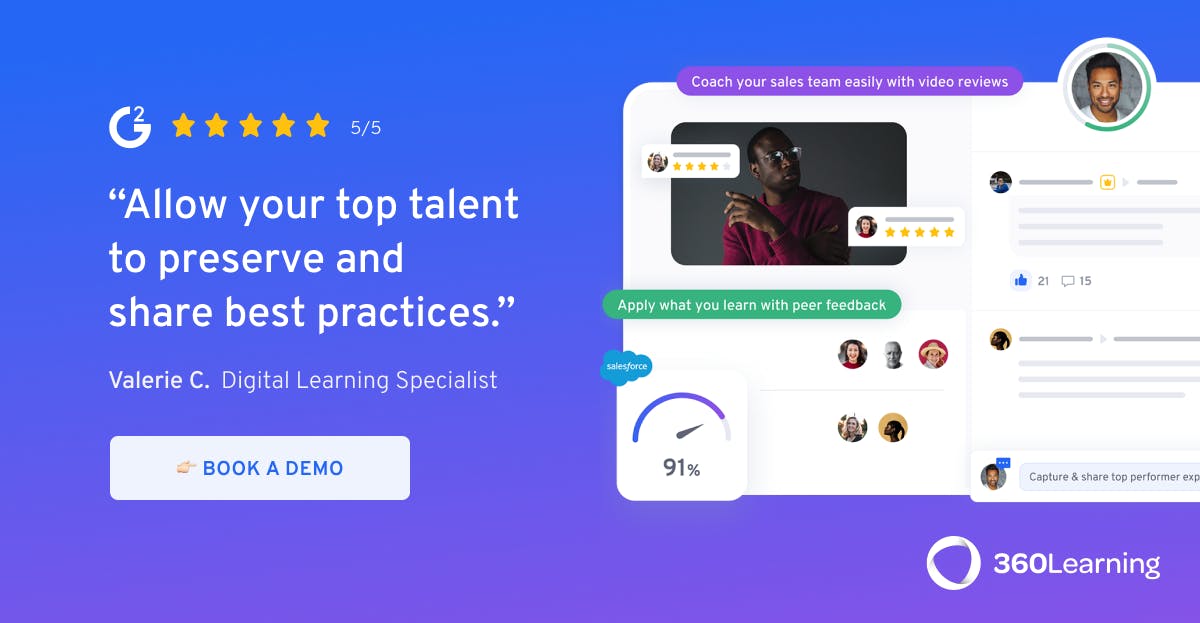Rolling out a new Learning Management System (LMS) is both exciting and terrifying. Your LMS could become an ocean of knowledge your employees look forward to swimming in—or, a dirty swamp they go out of their way to avoid. The stakes are even higher if you consider the fact that 75% of projects fail because they weren’t implemented correctly.
A smooth LMS implementation requires more than choosing a platform and filling it up with training courses. It involves goal setting, careful planning, regular (re)assessment, and a lot of strategic decision-making along the way. Every LMS implementation project plan will look slightly different, but a clear tried-and-true blueprint of the process will help you stick to a plan that's modeled after industry best practices and adjusted to fit your company's unique situation.
We laid out the building blocks that can help make your implementation successful. We'll start by breaking the LMS implementation process into two major phases: the build phase and the launch phase. Read on to find out how to nail both with eight straightforward steps. And if you're in the phase of evaluating vendors, our RFP template can help you make the best choice in less time:

Find the best LMS for your team.
By providing your contact info, you agree to receive communications from 360Learning. You can opt-out at any time. For details, refer to our Privacy Policy.
The build phase: Define your project and align plans with objectives
The build phase is when most of the thinking and planning takes place. This involves laying down clear objectives and deadlines, defining roles, and thinking about the content. Having clarity will make the implementation transparent and easy to follow for everyone involved.
Step 1: Identify training goals and spell out business objectives
As with any project, the first (and most important) step is to set goals for your new LMS. Nail down what you want to attain with the new system in relation to employee training and your organization. Setting goals will keep the implementation plan firmly on track.
For example, if your business objective is to increase sales, your training goal will be to train your sales reps faster and more often, and then calculate the impact of training on the win rate. You need an LMS platform that enables you to train them often and fast with new products and pitches as soon as your reps need them.
Here’s how to set goals and measure them:
- Think about and define specific business objectives that you want the LMS to address, like reducing training costs or increasing employee engagement.
- Lay down training goals that align with the business objectives you spelled out. If your objective is to reduce training costs and increase employee engagement, your goal could be to introduce an on-demand training program or peer-to-peer learning.
- Set key performance indicators for each training goal so you don’t get derailed.
Related: Our 3-Step Process for Using OKRs to Drive Performance (+ Free OKR Template)
Step 2: Choose an LMS with the features that meet your specific needs
44% of companies with learning technology think about replacing their solution within two years. That’s a significant waste of resources. Choosing an LMS is like choosing the right T-shirt. You have to account for your preferred style of training and pick the size that fits your organization. Unlike a T-shirt, tossing out your LMS can lead to plenty of discomfort and unmet business needs.
When choosing an LMS, it’s important to consider a handful of factors: user experience for learners and authors, the cost of the tool against the number of features it provides, and the ability to scale alongside the company’s goals.
Here’s how to choose the right LMS:
- Make a pool of shortlisted candidates. Do your research into the pros and cons of each LMS vendor, and zero in on a couple that have features that meet your needs. For example, if you want learners to have lots of social interaction and benefit from peer learning, go for an LMS that supports Collaborative Learning.
- Take into account other considerations like budget, trial periods, customer service, and user interface. Poor user experience is cited as a top reason by 87% of companies looking to switch their LMS. Read product reviews for positive and negative outcomes other customers faced.
- Create a request for information (RFI). An RFI helps narrow down the LMS providers who should get your request for proposal (RFP). It gives technology providers a peek into your organization and its resources, goals and initiatives, challenges, and core requirements.
Related: LMS Features to Consider When Choosing a Learning Management System
Step 3: Put together an LMS implementation team
Identifying and preselecting the people who will work to implement the LMS is a crucial step. A well-rounded crew of stakeholders with clear roles and responsibilities should work together to aim for the best output, while also being prepared for the unexpected.
Here’s who you will need on your LMS implementation team:
- A team leader, or project manager, who manages milestones in the implementation process and coordinates with other team members
- Subject-matter expert(s) from each major department or author(s) who will create manage content creation on specific topics
- An LMS systems specialist who manages the infrastructure, builds user profiles and ensures a positive user experience
- A communications manager who communicates with employees about the LMS and how to use it, getting them excited for the launch and keeping them engaged beyond it
- A representative from your IT department who handles data migration to the new LMS manages permissions and authentication for users, and resolves technical issues during and after the launch
- A sales director who identified the need for the LMS and internally promotes the use of the LMS. This person also follows and shares the impact of the LMS on the team’s performance.
Step 4: Set a reasonable time frame to implement your LMS
The timeline for your LMS implementation depends on the scope of your project, the experience of your team, and your chosen LMS. An on-premise LMS, which is hosted on your own server, can take anywhere from six to 12 months to implement, while a vendor-hosted solution, also known as a SaaS or cloud LMS, can take between three and nine months.
Create a realistic timeline because missed deadlines cost time and resources. Calculate the time and resources you have to dedicate to the project, account for a buffer period for obstacles along the way, and create a rollout calendar.
On top of outlining what tasks should be done when, your calendar can be a visual representation of how you’re delegating tasks among your LMS implementation team.
Step 5: Choose whether you will migrate existing content or create new learning content (or a combination)
Your company may already have existing online learning content, such as prerecorded webinars, interactive courses, or something else entirely. Before you launch your LMS, it is important to make decisions about whether you will be migrating existing courses, creating an entirely new body of courses, or hosting a mix of both.
This decision will require you to weigh the costs of starting from scratch against the cost of relying on existing content that might not clear the bar for quality.
Here’s how to prepare for content:
- Perform an inventory check to take stock of existing content that is still useful. This will help you figure out the need for courses, identify subject areas, and avoid duplication.
- Vet your content for compliance with the new tool and see if you need adjustments. Try to broaden your course creation to leverage the new LMS. If you only load SCORM-compliant content with a modern tool like 360Learning, you will not be able to maximize the full potential of the tool.
- Create new customized learning paths that are interesting and interactive so that learners are immediately hooked and stay engaged.
Related: Why Are We Still Stuck with SCORM? A Debate with L&D Experts

Step 6: Perform a pilot
Testing your LMS helps make the user experience better for the instructor and the learner. Perform a pilot with a small, diverse test group to make sure you are ready to launch and to ensure that best practices have been applied.
The objective of this beta test is to surface any setbacks, so you can tackle them before you actually launch. You'll want to engage managers to make sure that they are part of the communication plan and can relay relevant information to their teams.
Here’s how to do a pilot:
- Select between 20 and 50 learners who are diverse representatives of your future end users; be sure to include managers, admins, and training leaders to get their feedback.
- Bring in the learners to test the new platform's functionality. Gauge how intuitive the user onboarding process is, how long it takes authors to create course content, what they need in terms of resources, and how your learners react to courses.
The launch phase: Analyze and evaluate your new LMS to keep it running smoothly
The launch phase of your LMS implementation is when your LMS has been tried and tested and you are ready to get the wheels off the ground.
Step 7: Industrialize the experience from the beta test
By industrialize, we mean taking the learnings from the beta test and applying them to the live launch. You already have a blueprint from the beta test; now, you just need to pick what worked and leave out what didn’t.
Here’s how to launch your LMS:
- Announce the switchover from the beta test to going live and get employees excited.
- Replicate learnings from the test and apply them when you launch. Both the implementation team and learners are now fully immersed in the system based on their experience with the beta system.
Step 8: Gather real-time feedback to keep your LMS at peak performance
Once it's launched, your LMS's success largely depends on whether it works for the people it's meant to serve. So, it's critical to set up a system to collect their feedback in order to understand what's working, what isn't, and how to make your LMS the best eLearning tool possible for your unique team. The feedback gives you insight into your learners, their engagement, and course completion levels.
Here’s how to collect feedback and use it:
- Ideally, your LMS will make gathering feedback easy. A Collaborative Learning platform like 360Learning has feedback and Reactions built into it so that courses are live and constantly updated.
- Evaluate the feedback against the goals you laid down. Collect qualitative as well as quantitative feedback to get a feel for how employees are responding and whether your LMS is objectively performing against the outcomes you wanted to see from the beginning.

A successful LMS implementation is just the beginning
Implementation is not the finish line. In fact, it is just the beginning of your learning curve as an organization. Maintaining an LMS by establishing governance, setting goals, and tracking results will leverage your learning system to achieve its full potential.
Interested in learning more about 360Learning? Sign up for a free, custom demo.



